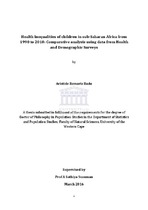| dc.contributor.advisor | Lochner, Michelle | |
| dc.contributor.author | Etsebeth, Verlon | |
| dc.date.accessioned | 2022-04-04T09:52:11Z | |
| dc.date.available | 2022-04-04T09:52:11Z | |
| dc.date.issued | 2020 | |
| dc.identifier.uri | http://hdl.handle.net/11394/9028 | |
| dc.description | Masters of Science | en_US |
| dc.description.abstract | Observations that push the boundaries have historically fuelled scientific breakthroughs, and these observations frequently involve phenomena that were previously unseen and unidentified. Data sets have increased in size and quality as modern technology advances
at a record pace. Finding these elusive phenomena within these large data sets becomes a tougher challenge with each advancement made. Fortunately, machine learning techniques have proven to be extremely valuable in detecting outliers within data sets. Astronomaly is a framework that utilises machine learning techniques for anomaly detection in astronomy and incorporates active learning to provide target specific results. It is used here to evaluate whether machine learning techniques are suitable to detect anomalies within the optical astronomical data obtained from the Dark Energy Camera Legacy Survey. Using the machine learning algorithm isolation forest, Astronomaly
is applied on subsets of the Dark Energy Camera Legacy Survey (DECaLS) data set. The pre-processing stage of Astronomaly had to be significantly extended to handle real survey data from DECaLS, with the changes made resulting in up to 10% more sources having their features extracted successfully. For the top 500 sources returned, 292 were ordinary sources, 86 artefacts and masked sources and 122 were interesting anomalous sources. A supplementary machine learning algorithm known as active learning enhances the identification probability of outliers in data sets by making it easier to identify target specific sources. The addition of active learning further increases the amount of
interesting sources returned by almost 40%, with 273 ordinary sources, 56 artefacts and 171 interesting anomalous sources returned. Among the anomalies discovered are some merger events that have been successfully identified in known catalogues and several candidate merger events that have not yet been identified in the literature. The results indicate that machine learning, in combination with active learning, can be effective in detecting anomalies in actual data sets. The extensions integrated into Astronomaly pave the way for its application on future surveys like the Vera C. Rubin Observatory Legacy Survey of Space and Time. | en_US |
| dc.language.iso | en | en_US |
| dc.publisher | University of the Western Cape | en_US |
| dc.subject | Sloan Digital Sky Survey (SDSS) | en_US |
| dc.subject | The Digital Palomar Observatory Sky Survey (DPOSS) | en_US |
| dc.subject | Dark Energy Spectroscopic Instrument Legacy Surveys (DESI) | en_US |
| dc.subject | Support Vector Machine (SVM) | en_US |
| dc.subject | Beijing-Arizona Sky Survey (BASS)2 | en_US |
| dc.subject | Mayall z-band Legacy Survey (MzLS)3 | en_US |
| dc.subject | Rank Weighted Score (RWS) | en_US |
| dc.subject | Dark Energy Camera Legacy Survey (DECaLS) | en_US |
| dc.title | Anomaly Detection With Machine Learning In Astronomical Images | en_US |
| dc.rights.holder | University of the Western Cape | en_US |




